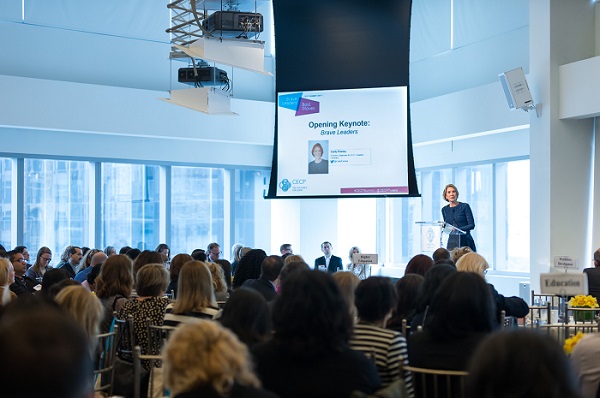Brave Leaders, Bold Moves was the theme of this year’s CECP Summit. A fitting start was Carly Fiorina’s opening keynote on Brave Leaders. She recounted several stories including her story of starting as an assistant in a real estate firm as she had studied History in college and didn’t like Law School. At work, there were two gentlemen who thought she was capable of more than typing and answering phone calls and encouraged her to get her MBA and the rest is history. She said “Everyone needs someone who sees their potential and takes a chance on them. Everyone needs a helping hand.”
Next, she recounted meeting with the women microfinance clients of Opportunity International, in the slums of New Delhi, only to find that they were filled with “Hope, pride, determination, focus” despite the most desperate situations that surrounded them, because “Someone took a chance on them and saw possibilities in them.”
In this way, Carly continued to relay story after story and through them highlight her definition of leadership: “Leaders ultimately see and seize possibilities by unlocking potential in the people around them.” She highlighted the difference between leaders and managers: “Leaders change constraints and conditions, challenge the status quo, leaders solve problems.” She talked about how leadership requires innovation, risk-taking and along with that comes mistake-making and the courage to handle criticism. “Criticism is the price of leadership, while problem-solving is the prize.” Leadership also takes character and requires collaboration, particularly with those that are different from us, which requires humility and empathy.
She implored the community of corporate philanthropists to invest in building the leadership capacity in the nonprofit sector as nonprofits lack the resources to invest in training their leaders. This was music to my ears as so often we as funders want to fund direct impact, and forget that it is people and leaders who solve problems and make impact happen. When we invest in nonprofits, we are ultimately investing in their people to solve complex social problems. We certainly see staff retention being an issue, and the lack of opportunity to develop skills and progress on an upward career path as limiting factors and therefore need to be part of the solution. There are a few companies, most notably American Express who are already building leadership capacity in the nonprofit sector in a meaningful way. We at Credit Suisse have started the journey of building the leadership capacity of our nonprofit partners thanks to the efforts of our Talent Development team who have delivered their leadership development curriculum to our charity partners after we surveyed our partners on their specific needs with respect to management and leadership training.
Continuing the thread of investing in nonprofit organizational capacity, we learned what Heron Foundation and Citi Foundation were doing in this regard.
Heron Foundation’s President, Clara Miller, talked about the quality of a nonprofit’s leadership and leadership’s ability to be transparent and recover from mistakes as necessary factors in making Heron’s decision to invest in these organizations in the first place. After she joined, Heron thoughtfully re-focused its grantmaking strategy on fewer partners making larger investments on a multi-year basis to enhance organizational capacity – average grant size went from $75K to $1.5M to fund a major systemic change the organization was going to undertake. Clara Miller, wisely distinguished between “enterprise capital” and “reliable revenue.” She talked about how nonprofits don’t have “profit” to reinvest in their organizations, and hence need this additional enterprise capital. The philanthropic community is in the best position to provide this risk-based capital. She also talked of exiting when the nonprofit had reached sustainability (on reliable revenues) to prevent overdependence on funders.
As another example of supporting this need, Citi issues a public RFP to encourage any organization involved in generating economic opportunity to apply for funding for building their capacity under a program called the Community Progress Makers Fund. Citi also provides technical assistance to its partners by hosting monthly webinars on different operational topics and provides a platform to share lessons learned. It also gathers its partners twice a year to provide leadership training and offers its partners communications coaching, enlisting its public affairs colleagues around the US in mentoring nonprofits.
I am hopeful given the conversations that followed these sessions, that we in the corporate philanthropic community can respond to Carly Fiorina’s thoughtful call to action and invest in a more meaningful way in developing the leadership and organizational capacity of the nonprofit sector. Credit-Suisse would love to hear what others are already doing with respect to filling this need.
What is your company doing to develop the next generation of leaders and build capacity? Email info [at] cecp.co and let us know!


